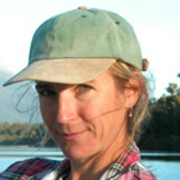
Peta Carey
Peta Carey grew up mainly in Christchurch. At age 19 she got her introduction to the screen industry, as a presenter for kids magazine show Spot On in 1984 (see 34 minutes into this Spot On special). University studies, an OE in France and a stint of ocean sailing all followed.
Carey feels her "biggest break" was the moment she became one of the young filmmakers set loose with Hi8 video cameras, on early 90s TVNZ series First Hand. The experience of capturing people's life stories was "the best way to learn the art of storytelling". After five 30 minute episodes of the show — including this episode on a community regatta — she honed her storytelling further with one-off TVNZ documentary The Mystery of North Head (1992), which looked into Auckland’s hidden World War ll tunnels.
Soon Carey was directing and story producing for current affairs shows (20/20, 60 Minutes, Frontline). A 60 Minutes report on a Catalina flying boat downed in the Pacific was picked up overseas. In 1995 Carey combined presenting and writing, circumnavigating the Pacific as one of three presenters on NHNZ series Deep Blue.
During a two year African OE in Kenya and Uganda in the late 90s, Carey shot stories ranging from HIV orphans to child soldiers, in videos made for UNICEF, the World Health Oorganisations and Uganda TV. Facing such traumatic subjects alone as a "one woman-band" often proved challenging.
On returning down under, she went to the Cook Islands to explore places that were Going Under, due to climate change. The same year Carey reunited with North Head producer George Andrews for Our Small World; they visited the tiny Pacific Atoll of Fakaofo in Tokelau, where the inhabitants were struggling to reconcile tradition and modernity. On her website, she describes the film as a "privilege to create".
Also in 1999, Carey teamed up with fellow First Hand graduate Leanne Pooley to follow the journey of a seven-year-old Kiwi schoolboy as he became the first Buddhist High Lama incarnated in the Southern Hemisphere. Conceived and directed by Carey, Kiwi Buddha sold to the National Geographic channel and 60 territories.
As the millennium turned, Carey was behind the tiller for a duo of NHNZ programmes produced for National Geographic’s extreme sport series, X Force. Science of Sailing got salt in its face exploring boat design and human endurance on the legendary Sydney to Hobart yacht race; Free Flight jumped off the edge of Southern Alps mountains with four of the world’s top paraglider pilots. The latter won awards at French and Spanish aerial film festivals.
in 2005 Carey shifted focus from epic adventure to the emotional and microscopic, for Lifting of the Makutu. Made by her production company Watershed Films, the TVNZ documentary explored the tragic loss of seven infants within a Māori family, and the work of a geneticist to find the cause of the deaths.
At the 2006 NZ Screen Awards, this tale of curses and molecular research won Carey a gong for Documentary Directing; it was also nominated for Best Documentary, and for Renaud Maire's camerawork. It won awards internationally, and Carey wrote a feature for North & South magazine on its subject, Dr Stephen Robertson.
Lifting of the Makutu is the project that Carey is most proud of to date, thanks to its impact on audiences, especially Pasifika and Māori viewers. "It was a very difficult film to make, to fund, and to complete. But a film that saves lives? I’ll take that as a winner."
In 2010, The Waterfall, made for TVNZ’s Artsville slot, returned Carey's camera to the southern whenua. Waterfall tracked a five day voyage in Fiordland, where four Kiwi artists (Gerda Leenards, John Walsh, Nigel Brown and Melvin 'Pat' Day) engaged with sublime landscapes, and the legacy of English painter William Hodges, who was ship's artist with Captain Cook. The doco shared an El Capitan award in the short film section of the 2011 Yosemite Film Festival, while Annie Collins was honoured for her editing at the 2011 Aotearoa Film and TV Awards.
Fiordland was a subject that Carey had earlier brought to the screen in Ata Whenua - Shadowland (2004). She produced this visual celebration of the World Heritage Area with her late husband, director, photographer and location scout Dave Comer. Shot by some of NZ’s most experienced cinematographers (Alun Bollinger, Mike Single) the film was especially made to screen at Fiordland Cinema in Te Anau.
In recent years, Carey has turned her attention to non-fiction writing; "My strength, I believe, is to take complex material and turn it into a story that is accessible and interesting."
She began in 2017 with A Place for the Heart - The Life and Work of Dave Comer. This was followed by Beneath the Takitimus in 2018, and Tamatea Dusky in 2020. The latter two books both focused on Fiordland.
Carey has also contributed written for North & South and The Listener, profiling everyone from legendary helicopter pilot Richard 'Hannibal' Hayes to kākāpõ conservationist Richard Henry, and covering topics from drowned islands to Russian aggression in Chechyna. Carey received a 2004 NZ Peace Media Award for North & South article 'Guardian Angels', on fishermen working to protect Fiordland’s marine environment.
Carey is Queenstown-based. She also keeps a crib at Whakatipu Waitai (Martins Bay), and is a trustee of the Hollyford Conservation Trust.
Profile published on 2 December 2015; updated on 29 November 2023
Sources include
Peta Carey
Peta Carey website. Accessed 29 November 2023